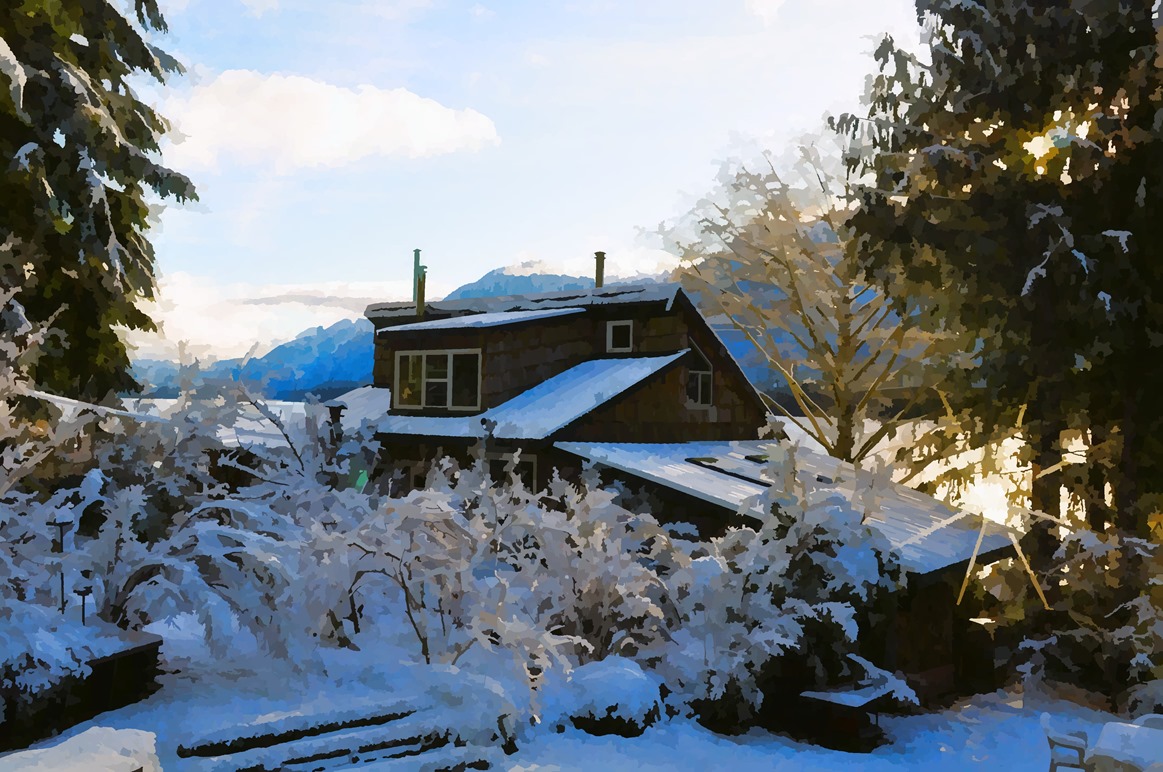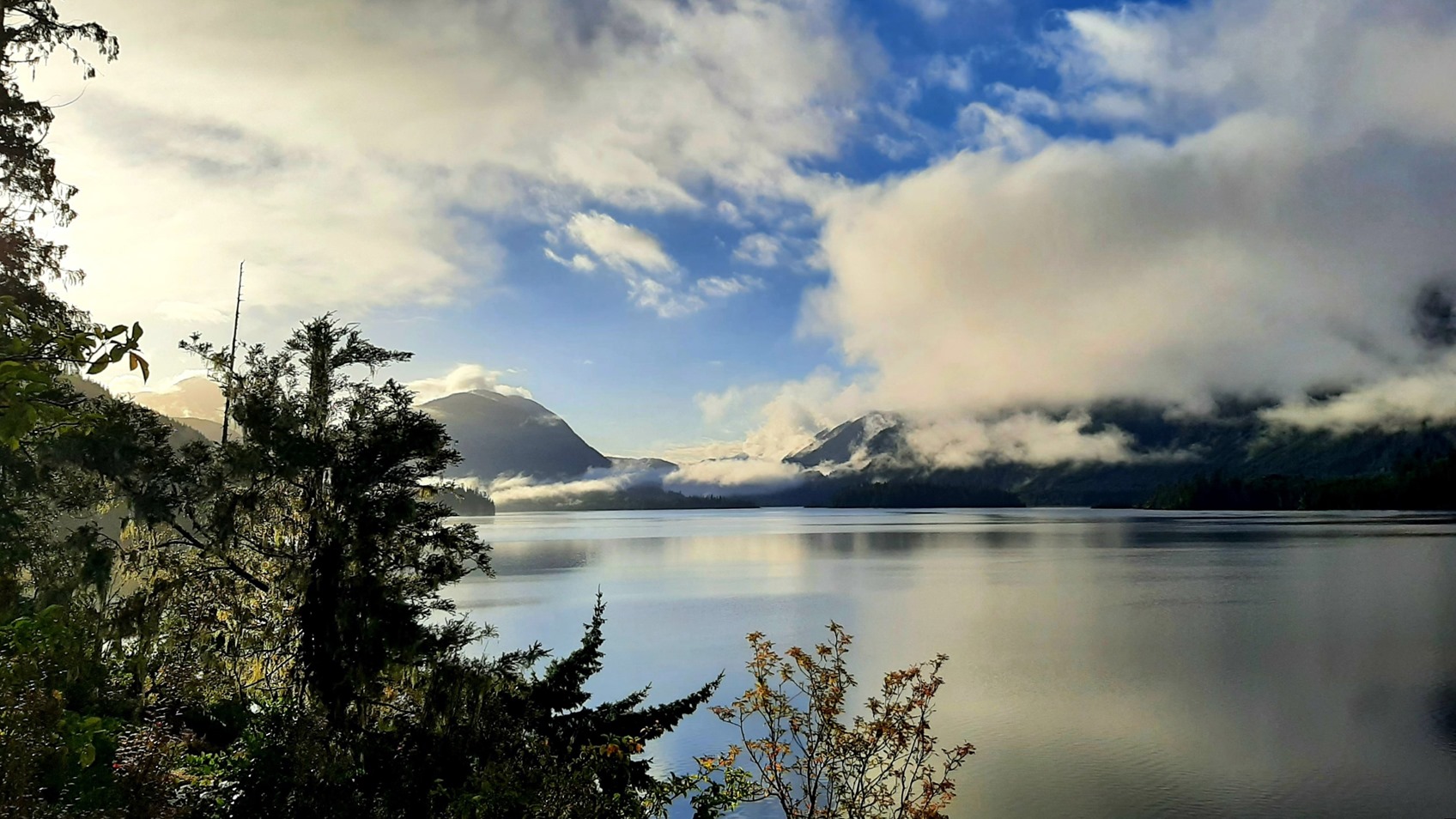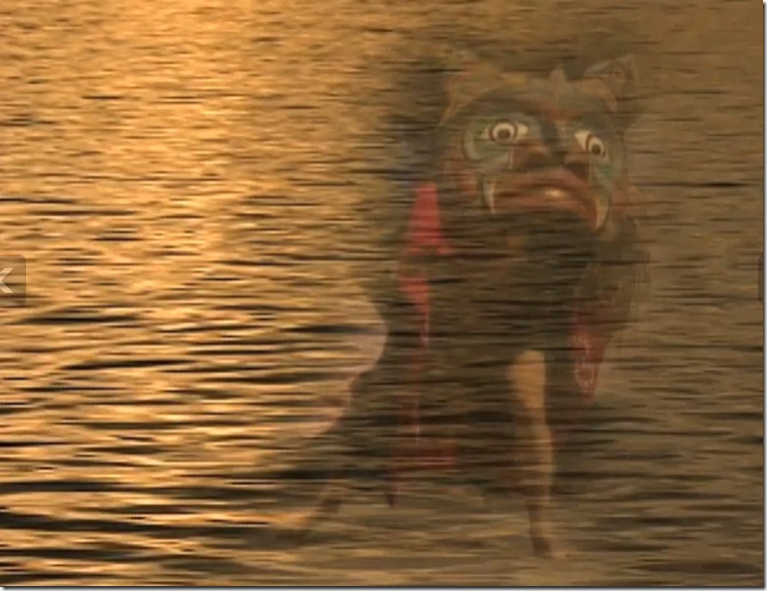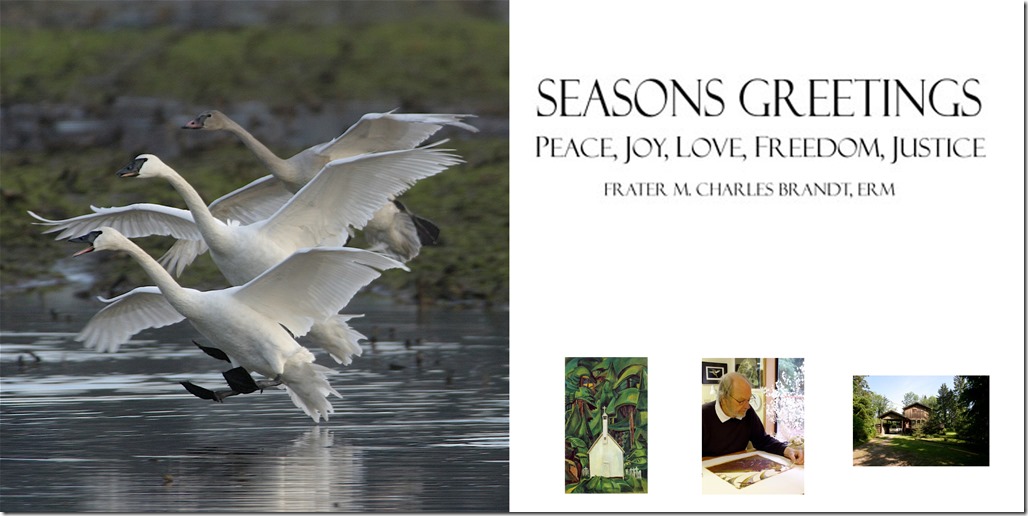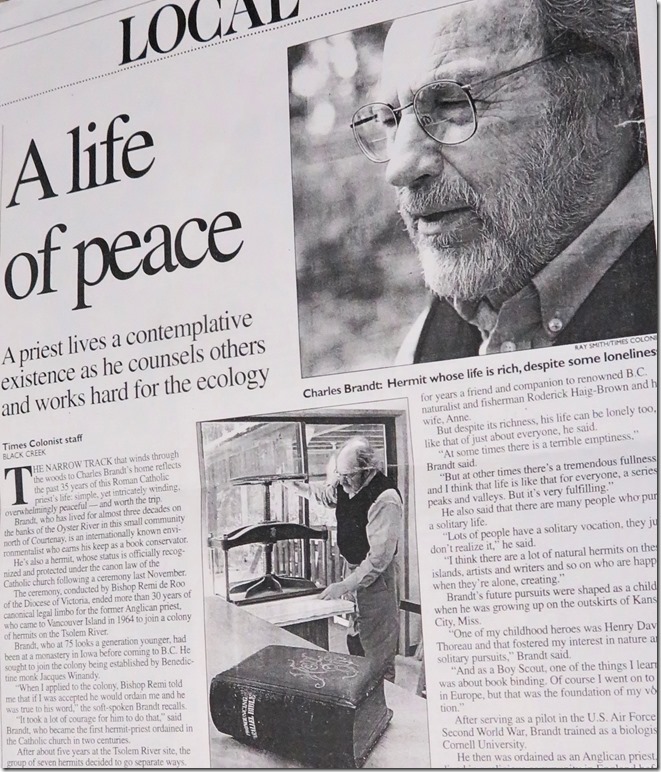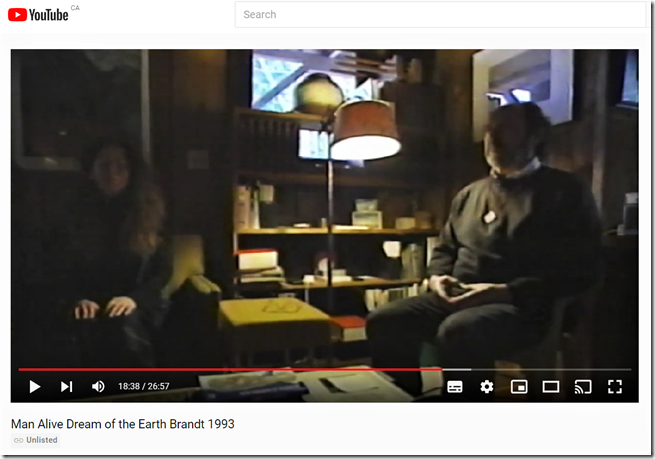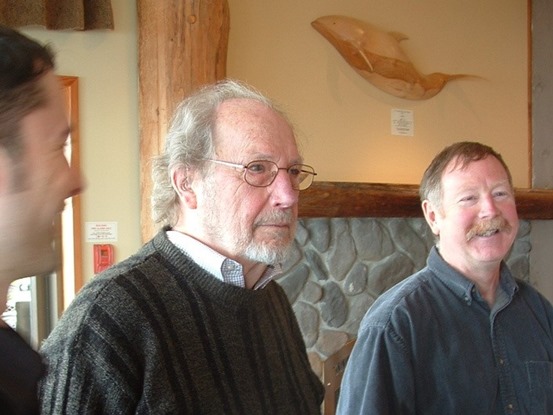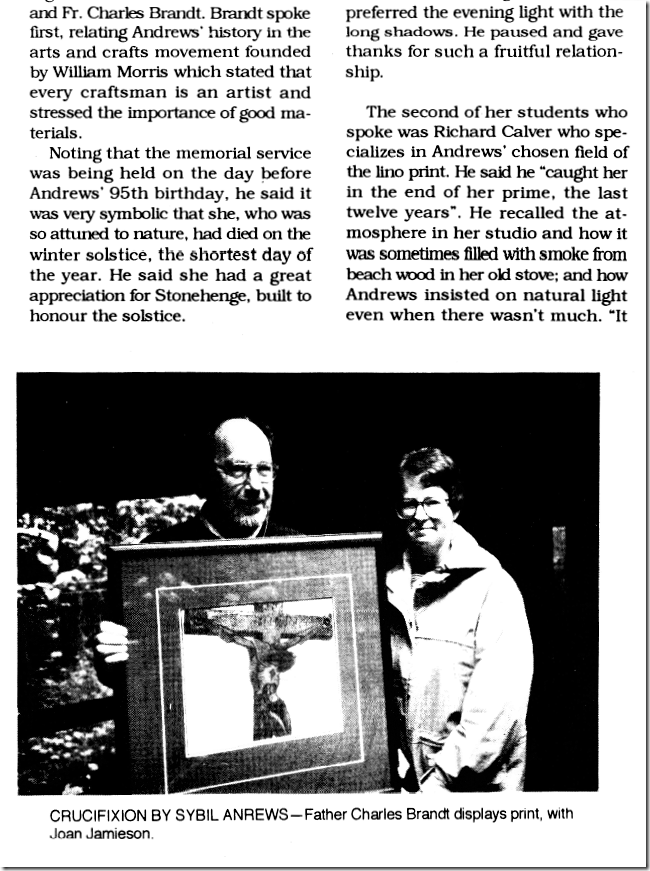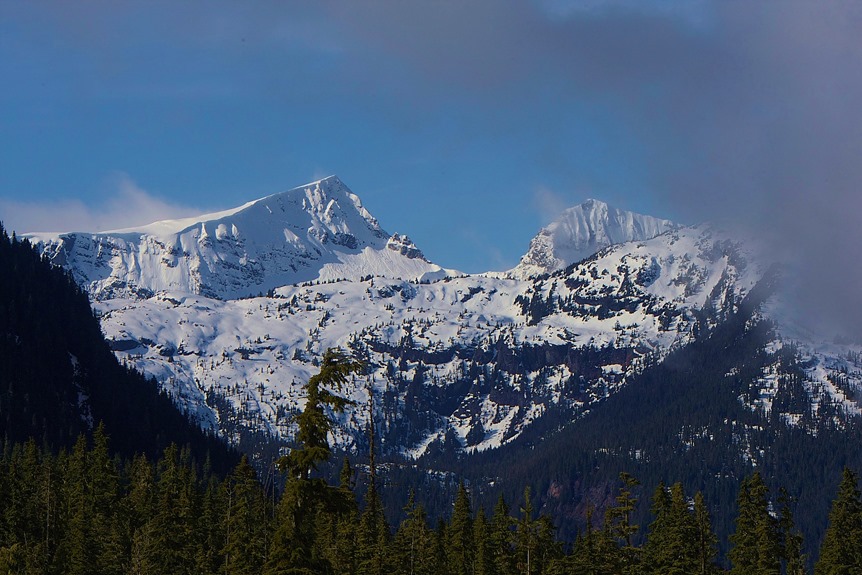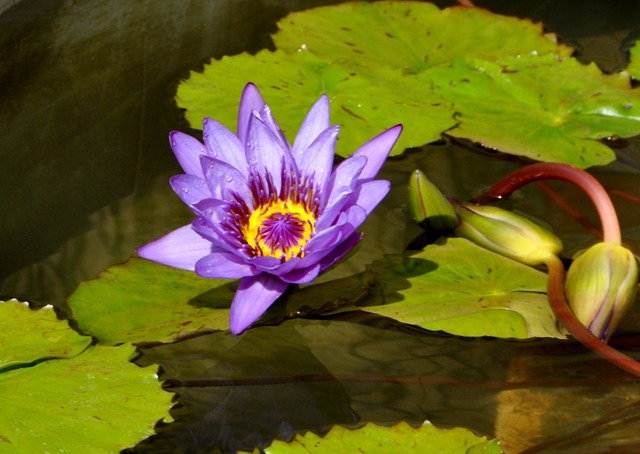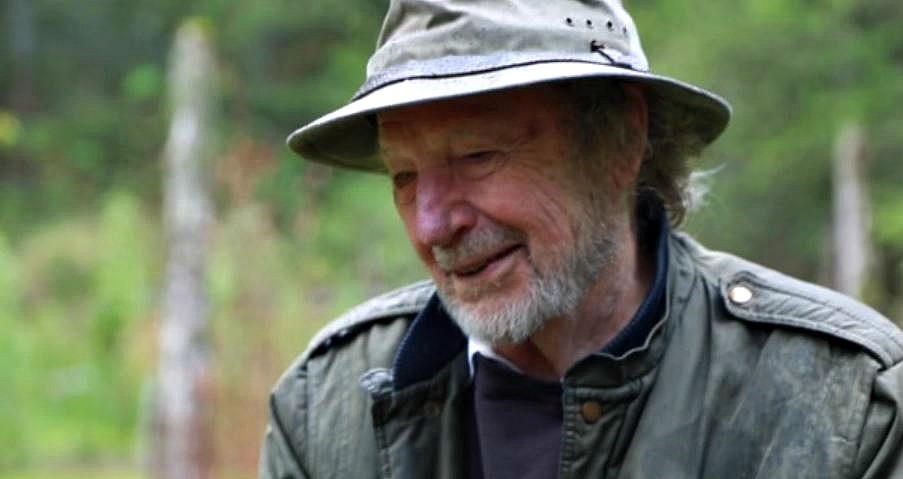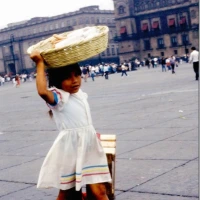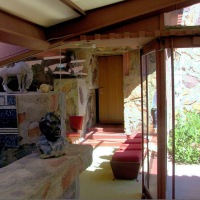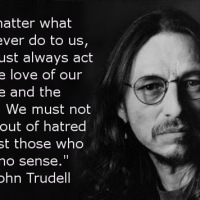BEAUTIFUL NORTHERN VANCOUVER ISLAND – 12 reflections by Darrell McIntosh
Darrell McIntosh is a retired long haul truck driver who retired to this area of Northern Vancouver Island about 14 years ago.
Here is some of his outstanding nature photos, with all locations nearby. How grateful I am for this beautiful wilderness area, and for Darrell’s inspiring outlook as well as his lasting friendship.
May each of you enjoy these images, and be well.
Cheers,
Bruce
~~~~
The British Columbia Coastal Mountain Range and Johnstone Strait
(as seen from Vancouver Island)
Humpback whales breaching in Neroutsos Inlet
Neroutsos Inlet and Walkout Island near Port Alice, BC
Black Bear (near Port Hardy, British Columbia)
Tidal pool with kelp in Neroutsos Inlet (near Port Alice, BC)
Side Bay on the West Coast of Vancouver Island
Bald eagle and fall colour (near Port Alice BC)
Two Bald Eagles on Northern Vancouver Island
Our off-grid cabin, on Northern Vancouver Island
Trail though the forest, on Northern Vancouver Island
Our passive solar home with solar array, on Northern Vancouver Island
Sun setting over Neroutsos Inlet and Port Alice, British Columbia
Darrell McIntosh Artists Webpage (all images by Darrell McIntosh, copyright)
~~~~
On Ecological Grief–an invitation to online forum Oct. 12
~ the Brandt Series ~
Although I haven’t posted for more than a year and this is short notice, tomorrow Oct 12 from 11 to 12.30 am Pacific Standard Time you are invited to attend the following forum focusing on Ecological Grief, hosted by the World Community for Christian Meditation.
It will be facilitated by Jason Brown who is a board member with the Brandt Oyster River Hermitage Society (please note the new website). Jason is also an instructor at British Colombia’s Simon Fraser University in the Department of Humanities and the School of Resource and Environmental Studies.
Here is the link to register: https://wccm.org/events/earthcrisisforum4
Jason will also tell us a little about the work of the Brandt Hermitage Society and the 2nd launch of Father Charles Brandt’s book, ‘Self and Environment’, republished by Medio Media.
Peace – Bruce
~~~~
~~~~
Emblems for a Season of Fury and Holy Wisdom – Thomas Merton
from the poem Hagia Sophia (Holy Wisdom) – by Thomas Merton, 1963
(first and and last verses)
There is in all visible things an invisible fecundity, a dimmed light, a meek namelessness, a hidden wholeness. This mysterious Unity and Integrity is Wisdom, the Mother of all, Natura naturans. There is in all things an inexhaustible sweetness and purity, a silence that is a fount of action and joy. It rises up in wordless gentleness and flows out to me from the unseen roots of all created being, welcoming me tenderly, saluting me with indescribable humility. This is at once my own being, my own nature, and the Gift of my Creator’s Thought and Art within me, speaking as Hagia Sophia, speaking as my sister, Wisdom.
The shadows fall. The stars appear. The birds begin to sleep.
Night embraces the silent half of the earth. A vagrant, a destitute wanderer with dusty feet, finds his way down a new road. A homeless God, lost in the night, without papers, without identifications, without even a number, a frail expendable exile lies down in desolation under the sweet stars of the world and entrusts Himself to sleep.
Christmastide, 2022
peace and goodwill for all
~ Bruce ~
Four Reasons for Hope
A few mornings ago, I awoke with a few linked and disparate thoughts about hope and despair, which I’ll attempt to share.
Recently I’ve been reading the Book of Hope by Jane Goodall and Douglas Abrams (with Gail Hudson) – subtitled, A Survival Guide for Trying Times. Published in 2021, the book is gleamed from dialogue between the co-authors in the two years prior to the current global pandemic.
The story begins at Jane’s home in Dar es Salaam, where Douglas had just arrived. He writes in this opening section, What is Hope, that “I had to admit I was suspicious of hope… I was afraid of false hope, that grim imposter. Even cynicism felt safer in some ways than taking the risk of hope.”
He tells Jane the joke about the difference between an optimist and a pessimist. The optimist thinks this might be the best of all possible worlds, and the pessimist fears the optimist is right.
Jane laughs. “We do not really know how it will turn out, do we? And we can’t just think we can do nothing, and everything will work out for the best.”
Douglas recalls how Archbishop Desmond Tutu had once told him that optimism can sometimes quickly turn to pessimism. Hope, Tutu said, is a much deeper source – practically unshakable. When a journalist once asked Tutu why he was optimistic he replied that he wasn’t – rather, “I am a prisoner of hope” he said, quoting the biblical prophet Zechariah. Tutu said hope is being able to see that there is light despite all the darkness.
As the book unfolds Jane focuses on “Four Reasons for Hope”:
1. The Amazing Human Intellect,
2. The Resilience of Nature,
3. The Power of Young People,
4. The Indomitable Human Spirit.
The book concludes with “Becoming a Messenger of Hope.” This, I’m working on.
Jane mentions one of her heroes as Albert Schweitzer – a musician, humanitarian, physician, and a theologian. Indeed, a Lutheran Minister. In his own way, Schweitzer speaks of hope:
No ray of sunlight is ever lost,
but the green it wakes needs time to sprout
and it’s not always granted the sower to live to see the harvest.
All work that is worth doing is done in faith.
To be fully human, we need hope. Jane Goodall gives four good reasons. And yet, in our being human there are moments when despair overwhelms us. What about those times?
Wendell Berry states the antidote – one we do well to turn to during these trying times – no matter what, or when. It’s written all around us.
The Peace of Wild Things
When despair for the world grows in me
and I wake in the night at the least sound
in fear of what my life and my children’s lives may be,
I go and lie down where the wood drake
rests in his beauty on the water, and the great heron feeds.
I come into the peace of wild things
who do not tax their lives with forethought
of grief. I come into the presence of still water.
And I feel above me the day-blind stars
waiting for their light. For a time
I rest in the grace of the world, and am free.
In faith, love (and hope)
~ Bruce ~
THE PROTECTORS
Even the white man, whose God walks and talks with him as friend to friend, cannot be exempt from the common destiny.
….The white man may one day discover; our God is the same God…. We may be brothers and sisters after all; we shall see.
Chief Seattle
~~~~
My brother Fred and his partner Haidee recently gave Francis and I three large framed photographs of Big Bear, Poundmaker and Crowfoot. These North American Indigenous leaders were pivotal in reducing the violence during Canada’s war against the Metis in 1885 – now known as the North-West Resistance.
Poundmaker is on the left, Big Bear is centre (longer hair removed while imprisoned), and Crowfoot is on the right.
Fred and Haidee inherited the photos from Fred’s sister-in-law Heather. Being too large for their small bungalow they felt they belonged with us in our lakeside cabin. Fred gave me a note explaining the back story of how Heather came to receive the pictures, which I typed out below. (Note Fred’s closing reference to Fr. Charles Brandt).
Background of the Protectors
When Heather left the University of British Columbia in the early 60’s with enough credits to teach she took a job teaching at Buffalo Creek near 100 Mile House, where she stayed for a year till the following summer when she hitchhiked to Calgary. There she worked at Glen Bow Museum and eventually met Alan her future husband.
During a time at the museum, she acquired quite a bit of Inuit Art at a time when it was gaining favour. Alan was a geologist so eventually was transferred to London, and when she left, the museum curator gifted her with framed photos of photos which were and still are a part of their collection. They had always appealed to her…
She hung them over her bed had and called them “her protectors.” Haidee also admired them and when she did so Heather said she wanted her to have them…
I think given yours and Frans interest in the struggles and people involved in the fight to maintain their rights – Big Bear, Poundmaker and Crowfoot belong with you and Fran. They shall now be your Protectors.
Love – Fred
As an aside, Heather had quite a lot of interesting and valuable art aside from the protectors. When a toilet tank broke while she was a way on vacation and a lot of water accumulated, she had Father Charles in to restore the art, and subsequently they had dinner together ( Heather’s cooking) on several occasions, one being the only time I met Father Charles.
Fr. Charles Brandt working in his art and book conservation lab – photo by Taylor Roades
Here is the photo of Chief Big Bear at Freds home on the day we picked it up, sitting alongside a bookcase he recently built. Though a off topic, you can see Fred is a master cabinet maker. He used douglas fir lumber milled by a local friend of mine.
To expand on the story of these First Nations leaders, the North-West Resistance Movement of 1885 was originally named the North-West Rebellion from the perspective of the white colonial conquerors. This 5 month period of escalated violence on the Canadian Prairies, was largely fought between the Metis Peoples and the North West Mounted Police (precursor’s to todays Royal Canadian Mounted Police or RCMP).
The Canadian Pacific railway was still under construction heading west. Under the iron hand of Canada’s first Prime Minister John A. McDonald, 3000 troops were sent from Ontario to Saskatchewan in just 11 days. This force quelled the resistance.
The Prime Minister also instituted in 1883 Canada’s terrible Indian Residential School system. Many First Nations children were forcibly taken from their elders and placed in boarding schools that were overseen by Canadian churches. This lasted for more than a hundred years. It has left a horrific legacy for all Canadians, most especially the Aboriginal peoples.
Emily Carr painting – Aboriginal Schoolhouse, Lytton, BC, 1910
Mural of Louis Riel (right) in Duck Lake, Saskatchewan – left, John A. McDonald
After the 1885 North-West Resistance there were numerous trials.
The great Metis leader Louis Riel (who was a founder of the province of Manitoba) was found guilty of treason against the fledgling nation of Canada, and he was sentenced to hang. Big Bear and Poundmaker were also tried and both served time in Canadian Penitentiaries – even though they had been instrumental in reducing the violence and saving many lives.
Big Bear, a Cree, had also resisted moving his people onto a reserve. The Canadian government cut off food rations to Big Bear’s Tribe causing starvation. This eventually forced Big Bear into signing Treaty 6.
Broken Treaty – mural of Treaty 6 in Duck Lake, Saskatchewan
Poundmaker was Cree and the adopted son of Chief Crowfoot of the Blackfoot Confederacy. After serving 7 months in prison Poundmaker was released in 1886. He died soon afterwards of tuberculosis at age 44.
In 2019 the Canadian government posthumously exonerated him of his 1885 wrongful conviction and imprisonment.
Prime Minister Justin Trudeau stated, “we recognize that during his lifetime Chief Poundmaker was not treated justly nor showed the respect he deserved as a leader of his people. If we are to move forward together on the path of reconciliation, the Government of Canada must acknowledge the wrongs of the past.”
As for for Chief Crowfoots role during the North-West Resistance, he believed the fighting was futile and refused to have his people involved in the conflict. For this, William Van Horne of the Canadian Pacific Railway rewarded Crowfoot with a “lifetime railway pass”.
It stated, “good until otherwise ordered.” Crowfoot travelled by horse, like all plains Indians of the day.
~~~~
How can you buy or sell the land? We do not own the freshness of the air or the sparkle of the water. How can you buy them from us? Every part of the earth is sacred to my people, holy in their memory and experience. We know the white man does not understand our ways. He is a stranger who comes in the night, and takes from the land whatever he needs. The Earth is not his friend, but his enemy, and when he’s conquered it, he moves on. He kidnaps the earth from his children. His appetite will devour the Earth and leave behind a desert. If all the beasts were gone, we would die from a great loneliness of spirit, for whatever happens to the beasts soon happens also to us. All things are connected. Whatever befalls the Earth, befalls the children of the Earth.
Chief Seattle
Emily Carr Painting – an Indian group, Hazelton BC, 1912
Guyasdoms D’Sonoqua (Wild Woman of the Woods) – Emily Carr Painting, 1928
Peace and love
Bruce
~~~~
Postscript:
After reading this post my good friend Dave Stevenson shared with me this poem he had written previously… it relates, completely:
(1825 – 1888)
he does not smile for the camera
sits, obedient at last
defiance mixed with a sneer
tethered by a chain
for an image that will outlast him
the painter offers to render
him more justly with his palette
places him on a black horse against
an azure bright prairie July sky
the sound of hooves drumming the earth
cannot be heard
colours him in brown hues
against a yellow prairie grass
spotted with vermilion stains
of buffalo blood squirting out from
the accurate bullet hole placed just behind
the massive head, eyes shining
flashing out fear against
the sombre brown grass
colours his smile white against
a copper glow of beauty.
places the picture
in the museum of art
for all to see
David Stevenson
Comox
March 2018
“The Bear” – a short story by Charles Brandt
~The Brandt Series~
Introduction – by Bruce
Since time immemorial, the forests and rivers of the pacific west coast bio-region of North America (sometimes known as Cascadia) has held a relationship between the salmon, the bears and the First Nations Peoples.
Today (as always), this interconnectedness extends to all that Is.
North Vancouver Island – photo by bruce witzel
In 2018 the hermit-priest-ecologist Fr. Charles Brandt said this in an interview:
“I’m a fisherman, and I used to do fishing, catch and release, and I’ve given that up now, because I realized that once that hook gets into that mouth, they feel some pain, and the Buddhists want all pain to cease, all suffering…. The big thing with the Buddhists is their respect for life; that all life is precious, and that’s really influenced me.”
Much earlier (in the 1990’s) Charles wrote “The Bear”, an allegorical narrative as a signpost to this. In its most basic form, it’s a good fish and bear story….
“The Bear”
Charles Brandt photo
I had never had a bear watch me fish before, although I have watched bears fish. It happened one morning on the Campbell River in mid July. I was in pursuit of summer-run steelhead, the run that had been introduced from the Tsitika River. These fish had been moving into the river since June and perhaps as early as May. For the past several weeks I had been coming into the river in the early morning. Each visit had been an event of outstanding proportions. It was not unusual to beach and release three or four steelhead in a two hour period. The experience never palled. There was always the excitement and anticipation of the first strike which jolted the creative forces and spontaneities of my inner being. The Campbell is the poor man’s Dean, yet rich beyond all telling.
This morning there was a difference in the air. I waded out comfortably across the bar to the Main Islands Pool to the riffle at its head to the point where the bar drops off somewhat sharply toward the main pool. I had the sense that I was being observed. There were some fishery technicians working on a side channel on the west side of the Lower Islands Pool to provide additional spawning area for chinook. There was that activity.
Many of us, I recall, were concerned that their work might alter the steelhead lies in the main river. But I sensed something I couldn’t quite put my finger on. It wasn’t the sense of bonding I always felt when wading the bar, the bonding with the other fishers of the river, mergansers, goldeneyes, herons and kingfishers as well as the trees along the bank and the other aquatic life in the river itself, but something else. This other life I always sensed was part of the sacred community of the natural world, not a collection of objects, but a community of subjects to be communed with, not primarily to be used or exploited. And the river is always a symbol of the journey that the universe is making, from its primordial flaring forth to the present terminal phase of the cenozoic.
This “Something Else” was the sense that I was being watched, yet I was the solitary fisherman on the river. When I arrived at the edge of the bar at the head of the pool, I played out line for the first cast. My favorite rod, a Goldenwest ten footer with a matching sink tip line, felt good in my hand. My fly was a No. 6 orange practitioner.
Father Charles Brandt steelhead fishing – likely about the early 1970’s
Moving slowly along the edge of the bar, covering as far as possible all of the water, eventually I arrived at a spot directly opposite the two dead sitka spruce on the opposite bank. This was the spot that Van Egan had identified for me, as a most likely spot for a strike, especially when your line is hanging directly downstream some seventy feet.
When the fly is hanging there, usually for a second or two, almost invariably a fish will take. And this morning take it did with a startling force and power that left me shaking with excitement. The fish made a powerful run toward the tail of the Pool where it surfaced in a great gleam of metallic light. Then back to the centre of the pool. She repeated the run, this time almost leaving the pool. I moved rapidly after her and noted that most of my backing was gone, hoping that she would not get into the fast water that emptied into the Lower Islands Pool.
When I finally began to gain some control of this amazing creature, now with most of my backing returned to the reel, for some reason I glanced over my right shoulder in the direction of the far bank. There it was! Sitting motionless in the midst of the salmon berry bushes and sword fern was a massive black animal, which had to be a black bear. It was peering directly at me, or at the fish on the end of my line. Unlike most black bear that I had encountered along the Oyster or Tsolum Rivers, which usually ambled away from me at a rather fast gait at my approach this critter sat motionless, apparently content just to observe. It had the appearance of a weathered totem, not unlike the ones that I had observed in the Gitsan country.
Last summer (l992) while fishing the Skeena below Terrace and the Bulkley at Barrets Station, I explored and photographed the Gitsan totems at Hazleton, Kispiox, Kitwanga and Kitwancool. One of the totem crests that figures prominently is that of the Bear.
Totems of Namgis First Nations ar Alert Bay – photo by Charles Brandt, 2005
I have always had a deep interest in the mythologies of the Northwest Coast indigenous peoples. They speak of a primordial age before the world became as it is now. A time when finite divisions between humans, animals and spirits had not yet been created, a time when humans could become animals by putting on skins, and animals could become human by taking them off. Everything was interconnected; water, earth, sky and land by beings who could pass through and among them. All was infused and penetrated by the Great Spirit. The totem carvings keep these mythologies alive.
Kispiox Totems – photo by Charles Brandt, 2005
Usually when fishing the Main Islands Pool I am able to bring a fish up onto the bar, somewhat downstream of the mid section of the Pool. There in the shallower water I am able to tail and release it in some fifteen or twenty minutes. But today she would not allow me to coax her onto the bar. She insisted with more than ordinary power that she wanted to remain in the Pool.
Some forty-five minutes after the strike, when she as well as I was beginning to tire, she allowed herself to be drawn onto the bar. I again looked in the direction of “The Bear”. It remained, unmoving. A bit apprehensive now of its presence, I decided to move the fish farther downstream so as to keep my distance from the bear when I would finally be able to beach this remarkable fish.
Finally, the fish was lying on her side in the shallow water against the berm that separates the Lower Islands Pool from the side channel. I knelt down to release the practitioner from the corner of her jaw. Just before I made the release I again glanced upstream to check on the bear. It was gone! Then I heard movement behind me, something crunching toward me across the gravel. Somewhat terrified, I quickly glanced around. There, towering over me was a large figure clothed completely in black. But it was not a bear, it was George Reid, Head of Fisheries, Ministry of Environment. It was his staff that had produced this marvellous fishery in the Campbell and the cutthroat fishery in the Oyster.
“Do you know how long you played that fish”, he asked. I replied that I couldn’t remember playing one that long. “I timed you” he said. “It took you fifty-two minutes”. Then, the scales fell away. I realized that the “Black Bear” I had seen observing me from the bank was none other than George Reid in black cords and sweat shirt.
With the hook removed, the fish drifted slowly downstream for a couple of seconds, caught its balance and the with lighting speed returned to the deep waters of the Pool.
Coho salmon alongside a cuthroat (not a steelhead) – Charles Brandt photo
As I left the river to make the trek back to the car, George was just ahead of me. I could hear him trudging up the steep trail. A mysterious hush descended on the forest as we climbed the steep bank to the parking lot. I still had several questions for George concerning his work with cutthroat in the Oyster.
When I arrived at the parking lot seconds behind him only my car was there. The spot where George usually parked was empty. And yet I had heard no car leave the lot. George was nowhere in sight. He had disappeared almost as suddenly as he had appeared along the river.
As I drove back to my hermitage on the Oyster River, the thought flashed through my mind that perhaps… just perhaps, I had really seen a bear along the banks of the Campbell. The mythologies of our own First Peoples came to mind: their belief that in a primordial age the divisions between humans, animals and spirits had not yet been created and beings could transform themselves from one form into another.
by Father Charles Alfred Edwin Brandt (Yde) 1993
Image courtesy of Namgis Nation Umitsa Cultural Center
Charles Brandt died in 2020 at the age of 97. His spirit of contemplation and action lives on:
(see hermitage brochure, below)
~ Peace ~
Bruce
Holy Thursday Meditation – April 14, 2022
“The greatest temptations are not those that solicit our consent to obvious sin, but those that offer us great evils masking as the greatest goods.”
― Thomas Merton
Holy Thursday Meditation
~~~
Let’s the world break bread together – not BOMBS!
An alternative world view – watercolour by b. thomas witzel, 1992
Peace and love for all,
Bruce
~~~
The upside of down, a Zen reflection
The way up is the way down
~~~~
peace, Bruce
AN INDIGENOUS STORY ON HEAVEN AND HELL – from the Novelist Barbara Kingsolver
Young Girl With Bread in Mexico City Bruce Witzel photo – Oct. 1992
~~~~
Some truths are best expressed in fiction. This is the wonder of story telling. And American novelist Barbara Kingsolver is a literary champion in this regard, and more.
Similarly, the beloved country folk-rock artist John Prine (sadly, an early victim of Coronavirus in April 2020) has said “There’s one thing I’ve learned about writing story songs: If you are writing story songs you better have a good ending. And if you don’t have a good ending, you better have a darn good moral to the story.”
When a friend recently lent me The Bean Trees, Barbara Kingsolver’s first novel published in 1988, I read it and wept with despair, and with hope. Three decades later it rings true to our times. Especially, the scene from the book I share below – and it has a good ending and a good moral!
The book jacket blurb and a list of characters will help set up the context:
Meet Taylor Greer, who grew up in poor in rural Kentucky with the goals of avoiding pregnancy and getting away. But when Taylor heads west with high hopes and a barely functional car, she meets the human condition head-on. By the time she arrives in Tucson, she has acquired a completely unexpected child and must somehow come to terms with both motherhood and the necessity for putting down roots. Hers is a story about love and friendship, abandonment and belonging, and the discovery of surprising resources in apparently empty places.
Lit of characters, setting and plot background:
· This scene takes place in the kitchen of youthful Taylor and Lou Ann, two single mothers who join forces to make ends meet by renting a small apartment in Tucson, Arizona.
· The two elderly women are their neighbours – Edna (who is blind) and Mrs. Virgie Parsons.
· Estevan and Esperanza (Hope) are a migrant refugee couple seeking sanctuary in America from death-ravaged Guatemala in the south.
· Turtle is the 3 year old “adopted” child of Taylor Greer, who narrates this scene.
Here is the borrowed snippet from The Bean Trees by Barbara Kingsolver –
AN INDIGENOUS STORY ON HEAVEN AND HELL
~~~~
Estevan produced a package, which turned out to be chopsticks. There were twenty or so of them wrapped together in crackly cellophane with black Chinese letters down one side.
“What is it, eating sticks?” Edna ran her fingers along the thin shafts. “It sounds like a great adventure, but I’ll just stick to what I know, if you don’t mind. Thank you all the same.” I noticed that Edna ate very slowly, with gradual exact movements of her fork. Mrs. Parsons said she wasn’t game for such foolishness either.
“I never said it was foolishness,” Edna said.
The rest of us gave it a try, spearing pieces of chicken and looping green-pepper rings and chasing the rice around our plate. Even Esperanza tried. Estevan said we were being to aggressive.
“They are held this way.” He demonstrated, holding them like pencils in one hand and clicking the ends together. I loved his way of saying, “It is” and “They are.”
Turtle was watching me, imitating. “Don’t look at me, I’m not the expert.” I pointed at Estevan.
Lou Ann came back to the table. “Where did you learn how to do that?” she asked Estevan.
“Ah,” he said, “this is why I like chopsticks: I work in a Chinese restaurant. I am the dishwasher.”
“I didn’t know that. How long have you worked there?” I asked, realizing I had no business thinking I knew everything about Estevan. His whole life, really, was a mystery to me.
“One month,” he said. “I work with a kind family who speak only Chinese. Only the five year old daughter speaks English. The father has her explain to me what I must do. Fortunately, she is very patient.”
Mrs. Parsons muttered that she thought this was a disgrace. “Before you know it the whole world will be here jibbering and jabbering till we won’t know it’s America.”
“Virgie, mind your manners,” Edna Said.
“Well, it’s the truth. They out to stay put in there own dirt, not come here taking up jobs.”
“Virgie,” Edna said.
I felt like I’d sat on a bee. If Mama hadn’t brought me up to do better, I think I would have told that old snake to put down her fork and get her backside out the door. I wanted to scream at her: This man is an English teacher. He did not come her so he could wash egg fu yung off plates and take orders from a five year old.
But Estevan didn’t seem perturbed, and I realized he must hear this kind of thing every day of his life. I wondered how he could stay so calm. I would have murdered somebody by now, I thought, would have put a chopstick to one of the many deadly uses that only Lou Ann could imagine it for.
“Can I get anybody anything?” Lou Anne asked.
“We’re fine,” Edna said, obviously accustomed to being Virgie’s public relations department. “You children have made a delightful meal.”
Esperanza pointed at Turtle. It was the first time I ever saw her smile, and I was struck with what a lovely woman she was when you really connected. Then the smile left her again.
Turtle, wielding a chopstick in each hand, had managed to pick up a piece of pineapple. Little by little she moved it upward toward her wide-open mouth, but the sticks were longer than her arms. The pineapple hung in the air over her head and then fell behind her unto the floor. We laughed and cheered her on, but Turtle was so startled she cried. I picked her up and held her on my lap.
“Tortolita, let me tell you a story,” Estevan said. “This is a South American wild Indian story about heaven and hell.” Mrs. Parsons made a prudish face, and Estevan went on. “If you go to visit hell, you will see a room like this kitchen. There is a pot of delicious stew on the table, with the most delicate aroma you can imagine. All around, people sit, like us. Only they are dying of starvation. They are jibbering and jabbering,” he looked extra hard at Mrs. Parsons, “but they cannot get a bite of this wonderful stew God has made for them. Now, why is that?”
“Because they are choking? For all eternity?” Lou Ann said. Hell, for Lou Ann, would naturally be a place filled with sharp objects and small round foods.
“No,” he said. “Good guess, but no. They are starving because they only have spoons with very long handles. As long as that.” He pointed to the mop, which I had forgotten to put away. “With these ridiculous terrible spoons, the people in hell can reach into the pot but they cannot put the food in their mouths. Oh, how hungry they are! Oh how they swear and curse each other!” he said, looking again at Mrs. Parsons. He was enjoying this.
“Now,” he went on, “you can go and visit heaven. What? You see a room just like this first one, the same table, the same pot of stew, the same spoons as long as a sponge mop. But these people are all happy and fat.”
“Real fat, or do you mean just well-fed?” Lou Ann asked.
“Just well-fed,” he said. “Perfectly, magnificently well-fed, and very happy. Why do you think?”
He pinched a piece of pineapple in his chopsticks, neat as you please, and reached all away across the table to offer it to Turtle. She took it like a newborn bird.
~~~~
Excerpted from The Bean Trees, Pgs. 105-108 by Barbara Kingsolver
Other highly praised books and writings by Kingsolver are Prodigal Summer, Flight Behaviour, Poisonwood Bible, and Laguna. She has a degree in biology and has worked as a scientist. For 25 years she divided her time between the borderlands near Tucson, Arizona and the place she now calls home – a farm in the Southern Appalachians.
She is one of my favourite authors.
~ Cheers ~
Bruce
Oaxaca Campesina Women Preparing a Large Meal Bruce Witzel photo – Oct. 1992
~~~~
In the Wake of Charles Brandt, a Wellspring in Our Hearts
~ the brandt series ~
A photo essay
“We are all fellow-passengers on this planet earth, and we are all of us dependent upon one another for the happiness and welfare of the world in which we happen to live.”
Charles Brandt, 1947
Charles Brandt in his early hermit days, mid 1960’s
IN THE WAKE OF CHARLES BRANDT
The Annual General Meeting of the Brandt Oyster River Hermitage Society was held in early November at the Brandt Hermitage. It began with a short commemoration of frater Charles Brandt who died October 25, 2020. Covid 19 protocols were in place. The twelve people participating included two nurses, two teachers, two community development workers, two carpenters, one medical doctor, one silviculturist, one geotechnical consultant and an Oblate Benedictine, Karen Nicol, who is the active contemplative resident at the hermitage.
All those present gathered on the grassy area overlooking Oyster River. Everyone chose a small rock to hold and then they formed a sharing circle. Willa Canon spoke of the symbolism of stone, its integrity and strength. Bruce Wood read a passage on walking meditation written by Charles. Bruce Witzel welcomed everyone and thanked them for attending.
Each person then shared how they came to know of Charles and the affects his leadership had on them. George Wahl led the closing meditation. Karen Nicol called attention to a bald eagle that flew over our sharing circle, as in giving a blessing.
Bruce Witzel photo
As everyone moved into the hermitage for the Annual General Meeting, the stones were placed into Charles’ small chapel. Afterwards these stones were returned to the outdoors of the hermitage forest, near the wooden sculpture of St Benedict.
Karen Nicol photo
CONSTITUTION OF OUR SOCIETY
“The human community and the natural world must move forward into the future as a single sacred community, or we will perish in the desert. Only the sense of the sacred can save us.” – Fr. Thomas Berry
WELCOMING REMARKS FROM BRUCE WITZEL
As chairperson of the Brandt Oyster River Hermitage Society, I welcome you to the Merton House at the Brandt Hermitage and Forest.
artist unknown
It is clear each of us knows Charles Brandt in different ways. His diversity was profound.
Photo from the Tsolum River Restoration Society
Charles Brandt working at his book press
Charles in the hermitage library – photo by Bruce Witzel
For instance, Charles led the People of God in various church communities for most of seven decades – either as a humble monk or a faithful pastor.
Father Charles with a Comox Valley Parish, mid 1960’s (photographer unknown)
Bishops Gary Gordon and Remi De Roo with Charles and his nephew Gary McCue (b. witzel photo)
My word to you is “Only the sense of the sacred can save us.” – (from Charles Brandt Speaks)
And for those he gathered together in meditation groups and retreats, there was a deep contemplative fellowship linked to a profound ecological and universal consciousness.
Island Catholic News Notes from the late 1980’s – (Bruce is beside Charles)
Click here for full 1993 Man Alive episode about Charles –Dream of the Earth
At his hermitage Charles was a solitary hermit monk, and he freely acknowledged his loneliness at times.
Watercolour painting of Charles’ original hermitage building – artist G. Cunningham
With the environmental initiatives he helped realize like the Tsolum River Restoration, the Oyster River Enhancement and Friends of Strathcona Park, Charles was always reasoned, gentle and steadfast.
Oyster River Salmon Enhancement Facility under construction in the 1980’s – Charles Brandt photo
2017 British Columbia Community Achievement Awards
Click here for 3:12 video, 2020 Nature Inspiration Award with Charles Brandt
Oyster River – charles brandt photo
Pink salmon in the Oyster River – charles brandt photo
Sockeye Salmon during spawning season – charles brandt photo
As an expert birder and a wildlife conservationist, in his approach he was scientific and awed with reverence – both quantitatively and qualitatively, through his non dualistic manner of observing and being in the world.
House finch (female) – Charles Brandt photo
Redwing blackbird (female) – charles brandt photo
Trumpeter Swans – charles brandt photo
In the arts community and the cultural restoration and book binding world, as well as the paper conservation domains and the museums that Charles worked with he was not only known as a master, he was actually a genius.
Charles at Sybil Andrews memorial – photo from June 1993 Island Catholic News Article
Charles as director of the Mobile Conservation Lab – photo from Canadian Conservation Institute
Charles working in his conservation lab that was located in the hermitage – photo by Taylor Roades
With much of his life well lived in contemplation and prayer, Charles still found time to meld this with action. He became a loyal friend and a mentor who counselled people to open our hearts, minds and souls – to the earth and to each other.
Charles knew through deep experience that humanity belongs to the earth and that we are an integral part of the incredible web of life.
photo by Mac Witzel (Bruce’s dad, long-time friend of Charles)
He echoed Martin Luther King Jr. who boiled it down to this:
“All life is interrelated. We are all caught in an inescapable network of mutuality tied into a single garment of destiny. What affects one directly, affects all – indirectly.”
Charles wants us to fully comprehend this reality which he knew as Sacramental Commons. Pope Francis calls it integral ecology in his teaching “Laudato Si’ – On Care for Our Common Home”.
Within this understanding Charles believed “we must think like a mountain”.
Mount Albert Edward – photo by Charles Brandt
Each earthly being (human and non-human alike) have distinct and individual patterns – for human earthlings, we have our will.
Thich Nhat Hanh gives an example. Although the lotus flower is different from the mud, it needs the mud. And the mud needs the lotus.
photo by Bruce Witzel
Although distinct, nothing is truly separate. Charles wanted us to embrace this insight.
And, to “pay attention”.
from a quote sent by Charles
Charles’ faith was broad and inclusive. His was the basic Christian tenet that we are all One Body with many differing parts – the rich and the poor, the suffering and the voiceless, and the whole earth that sustains all life. This reality is represented in all of the true spiritual and religious traditions throughout this blue-green planet.
Respecting this diversity we must come to communion with one another, Charles said, to form a single sacred community – or we will perish together, in the desert.
In gratitude for your caring love dear brother, frater Charles Brandt
Bruce Witzel,
from the Brandt Oyster River Hermitage Forest – November 4, 2021
REFLECTION FROM CHARLES – A WELL SPRING IN OUR HEART
(excerpt from Self and Environment
It is early morning with its quiet and coolness. I walk out the old logging road to Catherwood Road. Catherwood is my connector to the outside world.
My hermitage is located deep in the temperate rainforest, on Oyster River, British Columbia. The logging road along with other trails through the forest is where I practice walking meditation.
Image by videographer Geoffrey Leighton
I do not think of the road as leading anywhere. It is the road to nowhere, the path on which I journey and have been journeying for a lifetime.
photo by Charles
When I walk this road I have no destination, no timetable or estimated time of arrival. I simply place one foot in front of the other, let all my cares, my anguish, angst, fears drop away. My breathing is in harmony with my pace, my pace is in harmony with the universe.
Image by videographer Geoffrey Leighton
And although this is the path of nowhere, in reality it is the path of everywhere, because it enables me to be in communion with the whole community of beings, beings which are diverse, interiorized, and each in communion with every other being in the universe.
I become present to the most distant star, and she to me, the ‘complicated web’ of interdependent relationships. Every atom of my being is present to every atom of the universe, and they to it.
photo compliments of Nasa – Death of a Star
~~~~~
We shall not cease from exploration
And the end of all our exploring
Will be to arrive where we started
And know the place for the first time.
(T.S. Eliot)
Humanity is set on a path of exploration that will lead to the realization of the oneness of the human community and the earth community. When that begins to happen and when it does happen we will truly know the place for the first time.

Click here for the film Turning Point –Charles Brandt and Thomas Merton by Geoffrey Leighton
We live in a dualistic, dysfunctional society that is intent on exploiting the natural world. We are in a crash situation, living between hope and despair. We have approached the bottom closely enough for us to begin to realize that we have to change.
Vancouver Island pulp mill in 1991 – bruce witzel photo
Smoke from Western North America forest fires of 2017 – bruce witzel photo
We sense that if we do not change, the human species could very well disappear.
Meditative Moment – photo by charles brandt
There is an attraction force present today beckoning us away from the pit of despair to the hope of a better world. A transformational process has begun that is leading us to a new age, the age of the earth.
Bleeding Heart – charles brandt photo
This transformation begins with the human heart, in the core of our spirit. We begin to detect a well springing up in our heart. Perhaps it is now only a trickle. But it will never run dry.
photo by Bruce Witzel
Sometimes it runs more clearly and evenly. At other times it seems to have gone completely underground. It is a life force that needs to be purified so that it will flow continuously.
It will lead to a transformation of our hearts and minds that will enable us to realize the unity of all beings and enable us to reach out with love to every creature in the universe.
Charles Brandt, from Self and Environment – 1997
Charles Brandt photos
Black Creek Estuary enters the Salish Sea
Recognizing the sacred in all
~ Seasons Greetings ~
Bruce
~~~~
Holly at the hermitage – charles brandt photo
~~~~
-
Join 1,214 other subscribers
Hover over and then click to go to detailed lists of these blogposts:
appropriate technology Architecture art BUILDING charles brandt + thomas berry CLIMATE CHANGE Cooking with the Sun Creativity + ecology Energy........ family FIRST NATIONS gardens Here comes the sun Landscapes Music Nature Our Lakeside Cabin People Photography poetry + Politics RACHEL CARSON Renewable Energy social justice SOLAR HOMES Spirituality Sustainability..... THAY ~ thich nhat hanh ~ thomas merton Wilderness Windpower writingHIGHLIGHTS and POPULAR POSTS:
Years through the luminary lens:
RECENT COMMENTS

A THREE PRONG APPROACH TO GOOD LIVING
-
1) REMEMBER OUR VOWS
2) PRACTICE PATIENCE
3) REFRAIN FROM OUTRAGEOUS BEHAVIOUR
-
RECENT POSTS:
- BEAUTIFUL NORTHERN VANCOUVER ISLAND – 12 reflections by Darrell McIntosh November 1, 2023
- On Ecological Grief–an invitation to online forum Oct. 12 October 11, 2023
- Emblems for a Season of Fury and Holy Wisdom – Thomas Merton December 25, 2022
- Four Reasons for Hope November 23, 2022
- THE PROTECTORS September 25, 2022
- “The Bear” – a short story by Charles Brandt June 15, 2022
- Holy Thursday Meditation – April 14, 2022 April 14, 2022
- The upside of down, a Zen reflection March 15, 2022
- AN INDIGENOUS STORY ON HEAVEN AND HELL – from the Novelist Barbara Kingsolver January 23, 2022
- In the Wake of Charles Brandt, a Wellspring in Our Hearts December 23, 2021
- “Have Not–Know Not–Possess Not” – St. John of the Cross November 16, 2021
- BOOKBINDERY AMONG FATHER CHARLES BRANDT’S ENDURING LEGACIES October 16, 2021
- Harvest Homestead Reflections September 26, 2021
- Britney Keeley’s opinion piece on Treaties August 11, 2021
- FUNDAMENTAL SYSTEMIC CHANGE June 24, 2021
- What is the Price of a Human? June 8, 2021
- SAILING TO THE MOON May 18, 2021
- Death of an Appalachian Justice Warrior May 17, 2021
- DO NOT STOP April 19, 2021
- Our Only World April 10, 2021
- GOOD FRIDAY MEDITATION and TEILHARD de CHARDIN April 2, 2021
- THE GREAT DAY THAT DAWNS January 22, 2021
- Suffer us not to mock ourselves with falsehood — T. S. Eliot January 8, 2021
- CONTEMPLATION IN ACTION — Remembering Frater Charles Brandt December 19, 2020
~ A CONTEMPLATION ~

GREENING LUMINESCENCE
NINE KEY PRINCIPLES OF ECO-LOGICAL CITIZENSHIP AND GLOBAL CONSCIOUSNESS
1) SUSTAINABILITY - For at least seven generations
2) GRASSROOTS DEMOCRACY
3) SOCIAL JUSTICE & RESPONSIBILITY - personal & global
4) NON VIOLENCE - a call to arms is the last choice
5) DIVERSITY - biological, cultural & spiritual
6) POST PATRIARCHAL CONSCIOUSNESS
7) SEXUAL & RACIAL EQUALITY
8) DECENTRALIZATION - of energy, politics & wealth.
9) ECOLOGICAL WISDOM
Atmospheric CO2 Counter
Translate to preferred language
- appropriate technology Architecture art BUILDING charles brandt + thomas berry CLIMATE CHANGE Creativity + ecology Energy........ family FIRST NATIONS gardens Here comes the sun Landscapes Music Nature Our Lakeside Cabin People Photography poetry + Politics Renewable Energy social justice SOLAR HOMES Spirituality Sustainability..... THAY ~ thich nhat hanh ~ thomas merton Wilderness writing
















